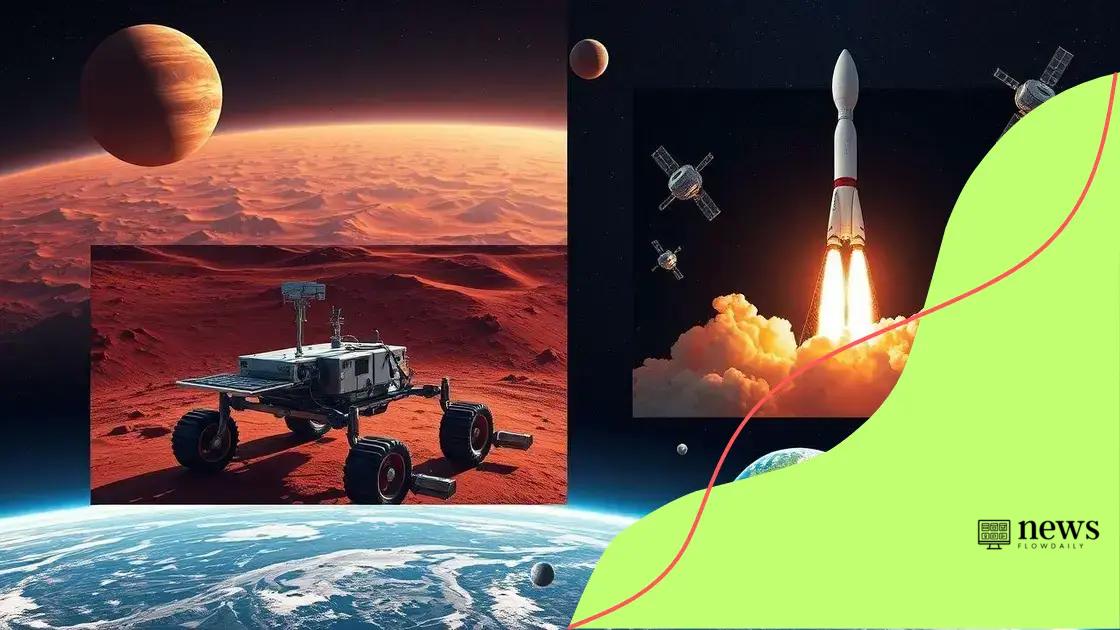Upcoming U.S.-funded space exploration initiatives

Upcoming U.S.-funded space exploration initiatives, such as the Artemis program, Mars Sample Return, and Europa Clipper, aim to advance human presence in space through international collaboration and cutting-edge technology.
Upcoming U.S.-funded space exploration initiatives are set to reshape our understanding of the cosmos. With investments in technology and international partnerships, the future looks bright for space enthusiasts. Are you ready to explore what’s next?
Recent projects in U.S. space exploration
Recent projects in U.S. space exploration are paving the way for innovative discoveries. These initiatives are not just exciting; they are crucial for understanding our universe better.
Mars Missions
The exploration of Mars is a top priority for NASA. Through the Perseverance rover, scientists are studying the planet’s geology and searching for signs of past life. Additionally, the Ingenuity helicopter is testing powered flight in another world.
- Collecting soil samples
- Searching for ancient microbial life
- Testing technologies for future human missions
Lunar Gateway Project
The Lunar Gateway is another groundbreaking project aimed at establishing a sustainable human presence on the Moon. This space station will orbit the Moon, supporting missions for exploration and research.
This project will enhance our ability to explore deep space and serve as a stepping stone for future Mars missions. With the Lunar Gateway in place, astronauts can spend longer times in lunar orbit and facilitate operations on the Moon’s surface.
Commercial Crew Program
NASA’s Commercial Crew Program showcases partnerships with private companies to send astronauts to the International Space Station (ISS). Through these collaborations, missions become more cost-effective while advancing technology.
- Launching with SpaceX’s Crew Dragon
- Increasing crew capacity on the ISS
- Supporting scientific research with regular missions
These remarkable projects in U.S. space exploration highlight ongoing efforts to expand human presence in space. With each step forward, we gain more knowledge, preparing for the next frontier of exploration.
Key players in U.S.-funded initiatives
Key players in U.S.-funded initiatives play a vital role in advancing space exploration. These organizations and agencies collaborate to drive technology forward and explore the unknown.
NASA’s Leadership
NASA, the United States government agency responsible for space exploration, leads many initiatives. With a long history of pioneering space missions, NASA sets the tone for innovation.
- Developing technology for crewed spaceflights
- Conducting scientific research on the ISS
- Collaborating with international partners
Private Sector Contributions
The private sector also has significant involvement. Companies like SpaceX and Boeing contribute to the success of U.S. missions by developing advanced spacecraft and launch systems.
SpaceX, for instance, has developed the Falcon 9 rocket and Crew Dragon spacecraft. Their innovations have made space travel more accessible. This collaboration showcases how public-private partnerships can enhance exploration.
International Partnerships
Alongside American companies, international partners are essential in U.S.-funded initiatives. Agreements with agencies like ESA (European Space Agency) and JAXA (Japanese Aerospace Exploration Agency) bring diverse expertise to the table.
- Joint missions to the Moon and Mars
- Shared resources and technology
- Enhanced scientific collaboration
These partnerships allow researchers to tackle challenges together, ultimately making space exploration more impactful. The contributions of these key players demonstrate the collaborative spirit needed for successful exploration.
Technological advancements driving exploration

Technological advancements are essential for driving exploration in space. As we push further into the cosmos, innovations are enabling new discoveries and making missions safer and more efficient.
Robotics and Automation
Robotic systems are transforming how we explore space. Rovers like Perseverance are equipped to analyze Martian soil and send data back to Earth. These robots can perform tasks that would be challenging or dangerous for humans.
- Advanced sensors for terrain analysis
- Autonomous navigation capabilities
- Real-time data transmission
Launch Technologies
Improvements in launch technologies are also crucial. Newer rockets, such as SpaceX’s Falcon 9, have significantly reduced costs and increased reliability. These advancements allow for more frequent missions.
Reusable rocket technology has changed the game by making launches more affordable. Each successful reuse of a rocket stage lowers the overall cost of space travel, opening the door for more missions and experiments.
Communication Systems
Modern communication systems enhance the ability to command spacecraft and receive data. With advancements in satellite technology, scientists can maintain real-time contact with missions far from Earth.
- High-bandwidth data links
- Improved signal processing
- Deep space communication networks
These technologies allow scientists to analyze data quickly, pushing the boundaries of what we know. The integration of innovative technologies is pivotal to our ongoing exploration journeys and the future of human presence in space.
Impact on international space collaboration
The impact on international space collaboration is significant, especially as nations work together to achieve common goals in space exploration. By pooling resources and expertise, countries can tackle challenges more effectively.
Global Partnerships
International collaboration has led to partnerships that enhance scientific research. For instance, the International Space Station (ISS) is a prime example where multiple countries work together to conduct experiments and share knowledge. This collaboration promotes goodwill and fosters innovation.
- Shared access to advanced technology
- Collaborative scientific experiments
- Enhanced training for astronauts
Joint Missions
Joint missions are becoming more common as countries look to explore deeper into space. NASA collaborates with the European Space Agency (ESA) and other organizations on missions to the Moon and Mars. These partnerships allow countries to share costs and reduce risks.
As countries join forces, they can combine their expertise and make discoveries that would be difficult to achieve alone. For example, missions to explore asteroids can benefit from the diverse skills and technologies available across different nations.
Impact on Policy and Funding
International collaboration also influences space policy and funding decisions. As countries cooperate, they can advocate for shared regulations and standards, creating an environment that encourages investment in space exploration.
- Creating a unified approach to space law
- Encouraging funding for collaborative projects
- Fostering transparency in space activities
This impact strengthens relationships between nations and advances our understanding of the universe. As we face global challenges, such as climate change, international space collaboration can lead to innovative solutions.
Future missions to watch out for
Future missions to watch out for will take space exploration to new heights. With several exciting projects underway, the upcoming years promise significant discoveries and advancements.
Artemis Program
The Artemis program aims to return humans to the Moon by 2024. This initiative not only aims to land the first woman and the next man on the lunar surface but also to establish a sustainable presence on the Moon. This will serve as a launchpad for future missions to Mars.
- Developing the Orion spacecraft for crewed flights
- Building the Lunar Gateway for long-term lunar operations
- Conducting research to support human missions to Mars
Mars Sample Return Mission
The Mars Sample Return mission is an ambitious project planned for the next decade. It aims to bring Martian soil and rock samples back to Earth for detailed analysis. This mission will help scientists understand the Red Planet’s history and its potential for life.
This multi-phase mission will involve the collaboration of NASA and ESA, combining expertise and resources. By sending robotic systems to collect samples and returning them, researchers can enhance our knowledge of Mars.
Europa Clipper Mission
The Europa Clipper mission is focused on exploring Europa, one of Jupiter’s moons. It is believed to have a subsurface ocean that may harbor conditions suitable for life. Scheduled for launch in the 2020s, this mission will conduct detailed reconnaissance of Europa’s ice shell and subsurface ocean.
- Using advanced instruments to study the moon’s composition
- Mapping the ice thickness and surface features
- Searching for signs of habitability
These upcoming missions are just the beginning. As technologies improve and international cooperation increases, humanity is poised to explore deeper into space than ever before, opening new frontiers in our quest for knowledge.
In conclusion, the future of U.S.-funded space exploration is filled with promising initiatives. With technological advancements and international collaborations, we are entering a new era of discovery. Upcoming missions like Artemis, Mars Sample Return, and Europa Clipper will not only expand our understanding of the universe but also inspire future generations. As nations unite in their exploration efforts, the possibilities for new scientific breakthroughs and innovations are limitless.
FAQ – Frequently Asked Questions about Upcoming U.S.-funded Space Exploration Initiatives
What is the Artemis program?
The Artemis program aims to return humans to the Moon by 2024, establishing a sustainable presence for future explorations.
How will the Mars Sample Return mission work?
The Mars Sample Return mission will send robotic systems to collect soil samples and bring them back to Earth for analysis.
What is the significance of the Europa Clipper mission?
The Europa Clipper mission will explore Europa, one of Jupiter’s moons, to study its potential for harboring life.
Why is international cooperation important in space exploration?
International cooperation allows countries to share resources, expertise, and reduce costs, ultimately leading to more successful missions.
